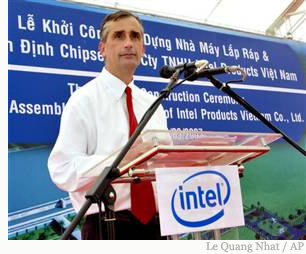Corporate America’s China plus one strategy
 LOS ANGELES, Jan. 31 – Traveling around California and Nevada these past two weeks (you guessed it, Las Vegas has got to be an essential stop on any self-respecting conference go-er) it struck me in talking to American businesses large and small how much the Far East is changing in perception for the United States. Perhaps now with an increased confidence in all things China, savvy U.S. corporations are instructing their business development managers – now 10, 15 years down the track of running around Beijing, Shanghai, Guangzhou and some of China’s second tier cities – to look even further a field – other domestic markets and other alien tax incentives beckon. The same is true, but for different reasons, for smaller businesses.
LOS ANGELES, Jan. 31 – Traveling around California and Nevada these past two weeks (you guessed it, Las Vegas has got to be an essential stop on any self-respecting conference go-er) it struck me in talking to American businesses large and small how much the Far East is changing in perception for the United States. Perhaps now with an increased confidence in all things China, savvy U.S. corporations are instructing their business development managers – now 10, 15 years down the track of running around Beijing, Shanghai, Guangzhou and some of China’s second tier cities – to look even further a field – other domestic markets and other alien tax incentives beckon. The same is true, but for different reasons, for smaller businesses.
One entrepreneurial businessman I met for martinis in the Bellagio was telling me China has gotten too expensive, and certainly now in Beijing, where he’s currently based. “Tianjin…” he said, “I need to consider relocating to Tianjin” referring to the major, yet somewhat shabby port city just 100 km east of Beijing. “Or failing that, Vietnam. I passed through there on my last Asia trip and it’s looking promising.”
The consistent views are interesting, and denote the beginning of what we shall dub the “China plus one” strategy that is forming in the minds of American businessmen. Two main factors are driving this, those two old chestnuts, economics, and opportunity.
The economics theory behind “China plus one” works like this: as China is getting wealthier, and its population older, it is getting more expensive to manufacture there. Wages are rising and so are the prices of commodities – China is experiencing some worrying inflationary trends right now that are pushing up the prices of everything from a bowl of rice to apartment rentals. Added to that, China unified its corporate income tax system last year, bringing the previous low rates that foreign businesses enjoyed up in some cases from 15 percent to 25 percent. Certain tax incentives also have disappeared, making other Asian destinations now more attractive than the PRC for the receipt of foreign investment. To compound this, the United States has quota systems in place for Chinese textiles, agricultural products and a whole host of other items, meaning once those quotas are used – and the annual quotas have tended to have been reached after just 9 months – there are no more permissible U.S. imports. Accordingly, some manufacturers are considering opening up elsewhere – or moving their operations entirely. Vietnam, with American most-favored-nation status is a prime recipient of this investment, especially for export manufacturers looking to sell back to the U.S. or markets elsewhere. It also has no U.S. quota-based issues to worry about.
The opportunity factor is different however. Still largely the preserve of the billion dollar plus multinationals, they perceive other markets in Asia as being prime for expansion to sell product too – India’s massive (and wealthy) middle class in particular – and they are adding that country to the destinations their hard pressed development executives are having to fly around.
The signs are on the wall. Every single American corporation I saw in California in the past ten days has a “China plus one” strategy. They may not have called it that, but they have it. “What do you know about Vietnam?” they ask. They have issues that need solving with staff they have already contracted and sent out to India to work on projects they’ve signed deals on. It’s already happening.
For many, the job of China expansion is done. The push into the inland regions there is proving financially unattractive. Other Asian destinations offer coastal facilities and in some cases demanding and growing middle class consumers on a scale that outstrips the Chinese. Why, after all, would you want to locate a new export manufacturing facility inland in China and away from the increasingly expensive coastal cities of Shanghai and Guangzhou, when you can have exactly the same plant slap bang on the coast in Vietnam or India, with an English speaking workforce and better tax investment incentives? You wouldn’t, and the savvy American boardrooms and entrepreneurs know this.
“China plus one” is the new expansion strategy for Asia, and corporate America is picking up on it.
Chris Devonshire-Ellis is the Senior Partner, International Practice of Dezan Shira & Associates and publisher of China Briefing, India Briefing and 2point6billion.com. He can be contacted here for matters of China, India & Vietnam investment comparisons and development strategy.
Further articles of interest:
China’s central regions and the Go Inland campaign
Should manufacturers move inland to avoid processing trade restrictions?
China-India investment comparision
Setting up foreign enterprises in India
- Previous Article China struggles to recover from worst winter storm in 50 years
- Next Article Chinese rubles



























